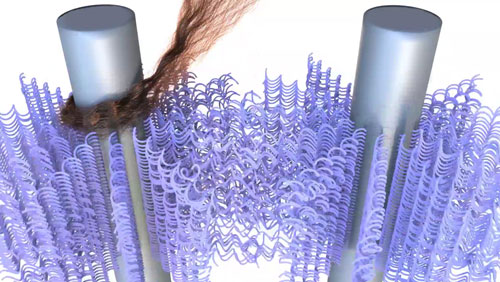| Posted: Sep 29, 2014 |
How things coil
|
|
(Nanowerk News) When one sends an email from Boston to Beijing, it travels through submarine optical cables that someone had to install at some point. The positioning of these cables can generate intriguing coiling patterns that can also cause problems if, for instance, they are tangled or kinked. The deployment of a rodlike structure onto a moving substrate is commonly found in a variety of engineering applications, from the fabrication of nanotube serpentines to the laying of submarine cables and pipelines, and engineers for years have been interested in predicting the mechanics of filamentary structures and the coiling process.
|
|
A team led by Eitan Grinspun, associate professor of computer science at Columbia Engineering, and Pedro Reis, associate professor of mechanical engineering and civil and environmental engineering at MIT, has been collaborating on a project that, in exploring these issues, bridges engineering mechanics (Reis’s group) and computer graphics (Grinspun’s group). The researchers combined precision model experiments with computer simulations and examined the mechanics of coiling, discovering in particular that the natural curvature of the rod dramatically affects the coiling process. Their study is published in the September 29 Early Online edition of Proceedings of the National Academy of Sciences ("Coiling of elastic rods on rigid substrates").
|
 |
| Discrete elastic rods, used for hair simulation here, are also being used to predict the coiling of undersea communication cables.
|
|
“This was a fun, fruitful collaboration,” says Grinspun. “We did something totally new and different: we took a computer algorithm that we had designed for Hollywood, and, by teaming up with Reis’s group, discovered that this same algorithm served as a predictive tool for engineering mechanics of thin filaments, rods, and pipes. It’s exciting to think that this computer model can serve both creative and engineering enterprises.”
|
|
Grinspun’s simulation technology, Discrete Elastic Rods, was originally developed to animate hair and fur in film and graphics applications, licensed and used in Photoshop for realistic paintbrushes, and by Weta Digital for use in films such as The Hobbit and Planet of the Apes series. Reis, who is an experimental mechanician at MIT, was studying how buckling of thin elastic structures can be turned on its head: buckling is normally feared by engineers as a potential failure of a design, but what if it could be used as a functional component of a design? The two researchers decided to investigate how cables are deployed, both at the nanoscale, in stretchable electronics, and the macroscale, such as the deployment of internet communication cables on the ocean floor.
|
|
“This has been a wonderful example of two seemingly unrelated fields coming together to address a practical problem to introducing powerful and novel computational tools that were not previously available in our engineering community,” Reis notes.
|
|
The collaboration between Grinspun and Reis began when Reis invited Grinspun to visit his lab at MIT. “We wondered if our seemingly distant worlds could be bridged by a common vision,” says Grinspun. “We both wanted to understand how physical objects move by looking at how their geometry, or shape, affects their motion. Cables, being long and slender, were ideal candidates for study. But could the technology we built at Columbia Engineering for visually striking film and special effects be sufficiently accurate to agree with Reis’s hard and precise experimental data?”
|
|
With support from the National Science Foundation, Reis and Grinspun recruited doctoral students Khalid Jawed (MIT) and Fang Da (Columbia Engineering) to study cable deployment in detail. In their PNAS article, the researchers describe how seemingly benign decisions, such as the diameter of a spool, or the speed at which a cable is deployed, can dramatically affect the way that the cable lies on the ground. They created a map of the different patterns that can arise, from a wiggling meandering mode to steady coiling and on to alternating loops, as the spool diameter or deployment speed are varied. The researchers also identified factors that have relatively little impact on the deployment, among them the height from which a cable is dropped.
|
|
“These findings have practical impacts on our everyday lives,” Reis adds. “Take, for instance, an email that travels along a transoceanic communication cable. By better understanding the variables that impact the deployment of such cables, we can better balance considerations such as expense (the length of the cable deployed, the amount of time to deploy the cable), signal quality (tangled cables can be more prone to interference), and the resilience of the connection (taut cables are more prone to damage due to external factors, such as seismic activity.”
|
|
“Translating computer tools from computers and validating them against precision model experiments has provided a novel tool for engineering mechanics to tackle the design and analysis of other rodlike structures, which are common in nature and technology,” Reis continues.
|
|
“As we move to the next stage, we would like to pursue engineering problems that combine the mechanics of slender filaments with additional ingredients, such as drag, contact, and friction,” adds Grinspun. “We are looking, for example, at locomotion of bacteria, tying of shoelaces, and hair blowing in the wind.”
|

